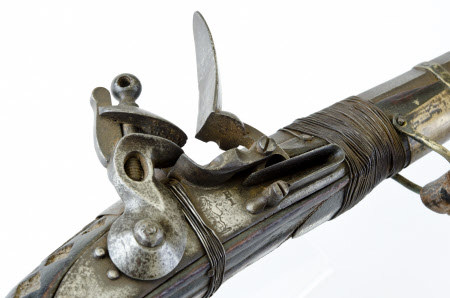Flintlock rifle
Category
Arms and armour
Date
1800 - 1900
Materials
mother-of-pearl, leather, brass, iron & wood
Measurements
140 mm (Width) x 60 mm (Depth); 1530 mm (L)
Order this imageCollection
Kedleston Hall, Derbyshire
NT 108505
Summary
A flintlock rifle, Sind, India, 19th century, the flintlock taken from a British East India Company musket.
Full description
Flintlock rifle, Sind, India, 19th century, the flintlock taken from a British East India Company musket. Iron octagonal barrel of Damascus twist construction, rifled with 7 grooves, the breech formed with a raised flange incorporating a peep-hole sight, the muzzle slight swamped and with a blade fore-sight. The barrel retained to stock by 11 decorated brass barrel bands and bound with wire at the breech end, which also secures the forward and middle sections of the lock. Iron ramrod with a decorative tip. Barrel length 115cm Calibre 15mm. Stock: Wooden full-stock with deeply curving butt of typical Sind form, with 2 large sections of the forestock covered with sheet brass. The butt and left side stock are decorated with diamond-shaped mother-of-pearl inlays (some missing). Horn butt-plate. Iron trigger guard and curved iron trigger. The forestock with 2 brass sling swivels, the forward swivel holder retained by the barrel bands. Leather sling decorated with red cloth medallions. English “Baker’s Pattern” flintlock with round section plate, a ring-neck cock and a “high hammer” frizzen. The plate stamped with rampant Lion crest of the East India Company, together the viewer’s mark (the initials & BI) indicating the date 1838-39. Retained to the stock by 2 side-nails. Overall length 152.5cm
Provenance
Purchased in 1987 by the National Trust from Francis Curzon, 3rd Viscount Scarsdale (1924-2000).
Marks and inscriptions
Lockplate: B I [rampant lion] (maker's mark, incised, on firing mechanism, text with image)
References
Elgood, 1995: Robert Elgood, Firearms of the Islamic World



